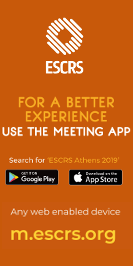Clinical and functional results following femtosecond laser-assisted DSEK vs microkeratome-assisted DSAEK surgeries: a comparative study
(results will display both Free Papers & Poster)
Session Details
Session Title: Cornea & Miscellaneous
Session Date/Time: Friday 15/02/2019 | 10:30-12:30
Paper Time: 11:18
Venue: Room MC3
First Author: N.Shilova RUSSIA
Co Author(s): N. Anisimova B. Malyugin
Abstract Details
Purpose:
To compare the clinical and functional results of posterior lamellar keratoplasty using a femtosecond laser (FS-DSEK) and an automated microkeratome (DSAEK) for graft preparation combined with cataract surgery
Setting:
S.Fyodorov Eye Microsurgery State Institution Moscow
Methods:
Prospective, randomized study. Thirty nine eyes (38 patients) with Fuchs endothelial dystrophy and cataract were enrolled. Group A: 19 patients who underwent cataract surgery combined with Femto-DSEK. Group B: 20 patients who underwent cataract surgery combined with DSAEK. Outcome measures were preoperative and postoperative BSCVA, pre-operative predicted spherical equivalent (SE) refractive target , actual postoperative SE, keratometry, corneal pachymetry and endothelial cell density (ECD).
Evaluation of transplant geometry was performed using the ratio between central to periphery graft thickness (C:P ratio), and the follow up period was 1 year following surgery.
Results:
At one year follow-up after surgery there were significant difference in BSCVA between group A to group B: median acuity was 0.4 (0.3;0.5) in group A and 0.3 (0.23;0.4) in group B (p=0.017). Median C:P ratio was 0.88 (0.85; 0.95) in group A and 0.55 (0.48; 0.68) in group B(p<0.001).Mean hyperopic shift in group A was 0.27±0.9D and 1.25±0.81D in group B (p=0.002). A correlation were revealed between hyperopic shift and C:P ratio of transplant, (r=-0.406; p=0.019). ECD loss at 1 year was higher in group A than group B and was 64.1±8.8% and 54.6±4.8%, respectively (p<0.001).
Conclusions:
Clinical and functional results in the early and one year follow ups were comparable between both surgical techniques. The use of femtosecond laser in comparison to microkeratome-assisted DSAEK obtains more uniform graft configuration and provides less hyperopic shift. A correlation between C:P ratio index and development of hyperopic shift was apparent in this study. This findings may have a clinical importance for choosing the proper power of an intraocular lens prior to the aforementioned surgeries.
Financial Disclosure:
-



